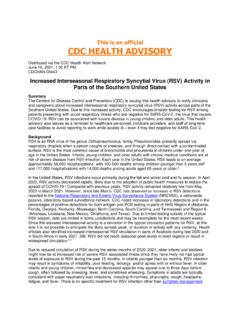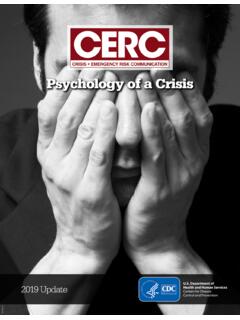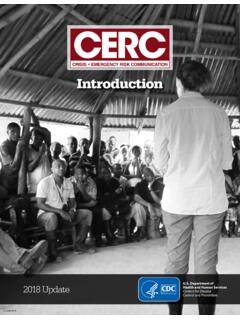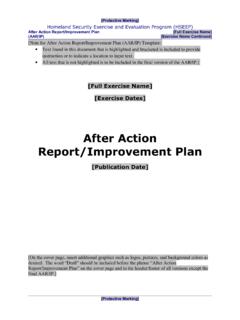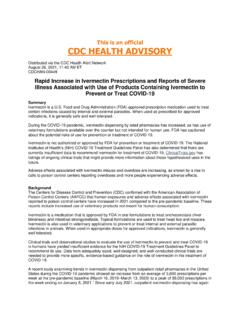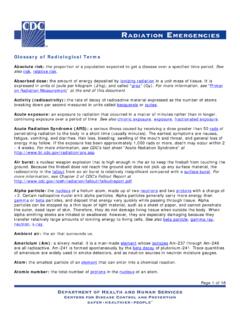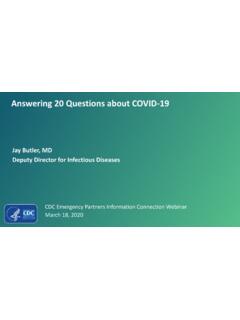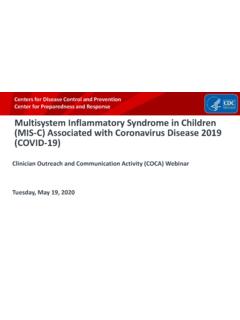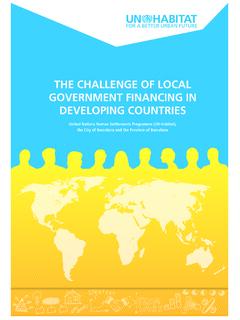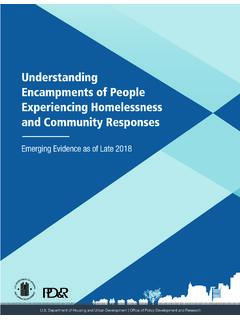Transcription of CERC: Understanding Roles of Federal, State, and Local ...
1 Crisis and Emergency Risk Communication: Be First. Be Right. Be Credible. CERC: Understanding Roles of Federal, State, and Local Community Health Partners Last Updated: 2014 1 CERC: Understanding Roles of Federal, State, and Local Community Health Partners CERC: Understanding Roles of Federal, State, and Local Community Health Partners To help explore the interaction of multiple groups during a disaster, this chapter reviews the Roles and relationships of health partner organizations. The Many Players and Partnerships in Emergency ResponseUnderstanding the communication Roles and responsibilities of the federal government and its counterparts at the state and Local levels can be challenging. Various stages of a crisis bring together many players, agencies, organizations, and interagency partnerships.
2 Each one is responsible for different, and not necessarily distinct, components of emergencies. Some of the key federal government agencies that may be involved1 include the following: Department of Agriculture (USDA) Department of Defense (DOD) Department of Energy (DOE) Department of Health and Human Services (HHS) Department of Homeland Security (DHS), including the Federal Emergency Management Agency (FEMA) Department of Justice (DOJ) Environmental Protection Agency (EPA) Federal Bureau of Investigation (FBI) Nuclear Regulatory Commission (NRC) Within each agency, separate programs or departments may handle different areas of a crisis, including the following: Planning Preparedness Training On-the-scene assistance Consequence management Coordination Communication 2 CERC.
3 Understanding Roles of Federal, State, and Local Community Health Partners In addition, nongovernmental organizations (NGOs) and faith-based organizations (FBOs) play a critical role in most disaster responses. These agencies and groups often have distinct missions, capabilities, and resources. Each may have a unique voice in the crisis and emergency risk communication (CERC) process. Change is a Core FactorNational, state, and Local government administrations change. Threats change. New technologies are developed and deployed. New or re-emerging incidents occur. The way incidents are handled and the reactions to the way they are handled will vary. These and other factors lead to a constantly changing environment of Roles and responsibilities: Most federal agencies will not be able to deploy assets during the first 48 hours following the onset of an ,3 Local , state, and territorial emergency communication managers will be first to respond to an emergency incident until federal assistance can be coordinated and deployed.
4 This happens because they are close to the scene. The true first responders will be members of the community itself: friends, family, and Existing practice emphasizes the role of Local response capacity and the private sector as opposed to over-reliance on national, public Approaches to EmergenciesA basic principle of emergency management is that all disasters are ,5,6 They happen at a specific place and the place is an important factor in the response. Local resources will be the first deployed to an event. Other important Local factors include: History Traditions Values Institutions Most victims of a crisis, for example, are first helped by family, friends, neighbors, coworkers, or even strangers as opposed to professional first Most of the injured or sick will likely be transported to medical facilities by private transportation.
5 Initially, resources for a response, such as bottled water and food, will come from private sector organizations within or near the community. 3 CERC: Understanding Roles of Federal, State, and Local Community Health Partners While federal and state resources and support will arrive, they will not be on the scene for at least several hours and possibly much longer. People affected by a disaster should be prepared for a 72-hour delay before federal or state help government response agencies seek to stabilize the crisis situation so communities can assume responsibilities. Long-term recovery and rebuilding most often become the primary responsibility of Local and state stakeholders and partners, with some assistance from federal groups. The realization of what federal agencies can and cannot do has led to new approaches.
6 One example is community-based disaster preparedness (CBDP), which is increasingly used as a general framework for promoting Local -level capacity CBDP seeks to develop the knowledge, resources, and capabilities of Local communities. This approach builds on the abilities of NGOs, such as the American Red Cross, Salvation Army, and FBOs, as well as private-sector organizations, Local governments, and businesses. CBDP is based on the realization that government agencies alone simply cannot achieve significant, sustainable risk reduction nor can they provide the level of support necessary to respond to major FEMA s Whole Community FrameworkFEMA s whole community approach recognizes that FEMA is not the nation s complete emergency management team. Instead, FEMA regards itself as part of a larger team.
7 In order to handle all phases successfully, from preparation through recovery, FEMA works with the entire emergency management community. 10 This whole community includes: FEMA and other federal agencies State, territorial, tribal, and Local governments NGOs and businesses Individuals, families, and communities, who are the biggest assets in emergency preparedness and responseAnother approach to emergencies is community This approach suggests communities may develop features and resources allowing them to reduce risks, respond more effectively, and recover more quickly. 4 CERC: Understanding Roles of Federal, State, and Local Community Health Partners The National Strategy for Public Health and Medical Preparedness states: Where Local civic leaders, citizens, and families are educated regarding threats and are empowered to mitigate their own risk, where they are practiced in responding to events, where they have social networks to fall back upon, and where they have familiarity with Local public health and medical systems, there will be community resilience that will significantly attenuate the requirement for additional assistance.
8 12 In a majority of cases, community members, family, friends, coworkers, neighbors, and even strangers will provide initial medical aid. In the case of severe disease outbreaks or epidemics, volunteers can run vaccination clinics, check in on home-bound neighbors and members of the community, and provide support to home-bound approaches are diverse because they must be matched to Local community conditions. They can be facilitated through a number of activities. These activities should involve the community leaders, institutions, businesses, partners, and PreparednessCommunities, Local organizations, and community health partners can do a great deal to enhance preparedness, including developing plans and stockpiling resources such as water, food, and batteries. Significant efforts have been directed toward encouraging preparedness through communication such as the One of the first steps in building community preparedness is to collect information about risks, resources, and response strategies: Inventory of information about risks to the community: yIdentify the risks a community is most likely to face.
9 YCompile information about the geographic location, site-based risks, history of events, and vulnerable populations. All of these may influence CBDP strategies. yUse this information to help in developing risk communication strategies. Information and data about available community resources: yInventory Local resources, capacities, and expertise that might be needed in disaster response. yUse this inventory to help identify deficiencies and increase the speed with which community resources can be deployed. Strategies for risk reduction: yMake long-term plans to reduce risks, such as the following: Develop flood mitigation strategies. Build schools a safe distance from industrial sites. Undertake fire reduction activities. yCommunicate about risks with stakeholders and : Understanding Roles of Federal, State, and Local Community Health Partners Communities that are connected via networks are more One of the most important components of community preparedness is building integrated communication networks, both formal and informal.
10 Communities that have well-integrated networks are able to pass information more quickly and with greater efficiency. These networks also can withstand technological disruptions by passing information through alternative means. For example, word of mouth between trusted neighbors can be used to pass information when radio and television broadcasting is networks between community groups, FBOs, NGOs, institutions, and businesses, as well as governmental agencies, can significantly bolster To help build, integrate, and sustain your community networks, involve these groups in your CERC preparedness activities, including the following: Planning activities Tabletop exercises and full-scale drills After-action debriefs Japan s Disaster Prevention DayJapan is known around the world as a leader in disaster preparedness.
